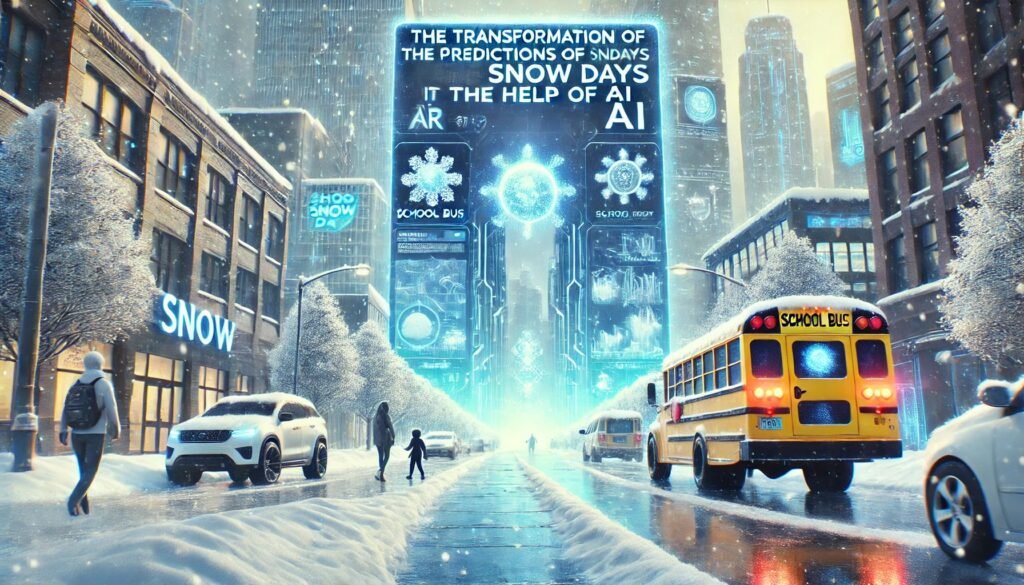How AI is Revolutionizing Snow Day Predictions
Artificial Intelligence (AI) is continually reshaping AI-driven technologies, forecasters, predictions, and algorithms specifically designed to predict snow days with the utmost precision. The integration of big data, machine learning, and real-time information makes it easier for schools, businesses, and even municipalities to make rational decisions based on the model AI gives. In this article, we will learn more about how AI impacts snow day predictions and the technologies integrated to make AI models more accurate. If you’ve been keeping track of AI innovations and would like to know more, head over to CHATGPTCLICK.COM and follow up on more AI innovations that are changing the world.
How AI Enhances Snow Day Predictions
1. Snow Fall Data Analysis and Machine Learning
AI-powered models integrate machine learning algorithms that work 24/7 to analyze historical US snow days calendar, snowfall data, and temperature trends to predict future holidays in schools for up to five years. By modeling events that happen apart, AI improves itself to better forecast snow days in the future.
2. AI-Enhanced Real-Time Data Processing
Weather prediction methods rely on a single person called a meteorologist who interprets weather maps and builds models to make predictions. AI, unlike people, can process real-time data from multiple satellites, weather stations, and sensors to give the right prediction in a matter of seconds.
3. Assimilation of Big Data
AI systems fetch and analyze data from a variety of resources, which include:
- Satellite images
- Doppler radar data
- Local temperature shifts
- Changes in atmospheric pressure
- Road surface temperature
All these parameters provide factors that determine how snow will accumulate and the ice coverage on boulevards and roadways.
4. Hyperlocal Prediction Using Deep Learning
AI techniques aim to enhance local forecasts’ level of accuracy and detail targeting snow day predictions. As opposed to traditional systems that use a region-wide scaffold or a whole portion of the globe to mark borders, AI utilizes more precise areas that are prone to snowfall and perilous driving conditions.
5. Decision Support Automation for Municipalities and Schools
The AI-powered snow day prediction systems deliver mandatory information required by school supervisors and other local government officials as follows:
- Probability score of a snow day.
- Impact evaluation involving the effects of the snowfall on transport and other safety measures.
- Automated notifications of potential closures for schools, public safety officials, and other relevant stakeholders.
Traditional vs. AI-Based Predictions on Snow Day
| Feature | AI-Powered Predictions | Traditional Methods |
| Data Processing Speed | Real-time | Hours to Days |
| Accuracy | High | Medium |
| Scope of Prediction | Micro/Meso Regional | Area-Wide |
| Undergoing Improvement | Yes | No |
| Support for Actions Taken Decisions | Automated | Manual |
Real-World Applications of AI in Snow Day Forecasting
1. In District School Boards
Most of the school districts are now using AI models for snow day prediction. AI-accessible models provide real-time checking of weather information and generate automated recommendations for school closures.
2. Smart City Implementation
AI for snow prediction systems enables the city to more effectively manage snow removal and salting of the streets. With the use of AI, it can predict the snowfall and effectively allocate resources, which lessens the danger on the road.
3. Public Transport Safety Concern AI
AI helps to keep roads safe by warning travelers of icy road conditions. AI applications also inform users in real-time if roads are closed and suggest alternative routes.
Future of AI in Snow Day Predictions
Advancements in drone technology will allow snow day predictions to become more precise in the future.
- AI-powered weather drones: Capturing snowing data in real-time.
- Neural Networks: Modern AI utilizes advanced neural networks for deep learning models to enhance forecast accuracy.
- IoT Integration: Devices adapted to IoT can provide real-time weather data from strategically placed sensors.
To learn about the latest trends in AI and technology, visit CHATGPTCLICK.COM and see how AI is revolutionizing every sector around the globe.
Frequently Asked Questions
1. In which ways does AI enhance predicting snow days?
AI enhances forecast precision by integrating real-time weather data, historical snowfall patterns, and associated meteorological considerations.
2. Is it realistic to assume AI can predict snow days with 100% accuracy?
Even if AI optimizes accuracy, the weather still has unpredictable elements due to constant changes in atmospheric conditions; therefore, achieving 100% certainty is not feasible.
3. How does big data impact the forecasts offered by AI?
AI’s access to large sets of meteorological data enables more accurate and timely predictions due to enhanced processing capabilities offered by big data.
4. Can the public access weather forecasts made using AI technologies?
Yes, numerous AI-driven applications and platforms provide public users with real-time access to snowfall forecasts.
5. Can we say that AI will replace human meteorologists?
Humans are still very much needed by AIs to interpret the complexities of weather, which means AIs assist – but do not replace – the work done by meteorologists.
Conclusion
With advances in machine learning, deep learning, and big data technologies, AI is transforming how snow days are predicted by providing accurate and timely forecasts. This will enable schools, cities, and even transport services to make optimal decisions in managing activities during winter. Accurate weather forecasts, such as those provided by the SnowDayPrediction.com calculator, play a crucial role in preventing safety issues and optimizing resource management during the winter season.

